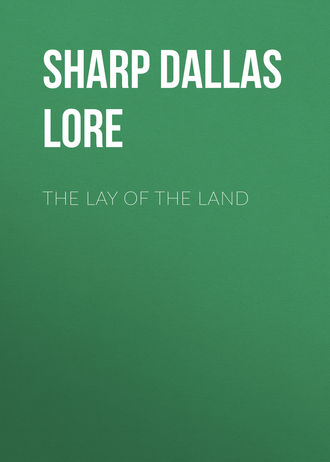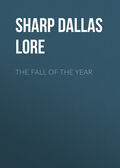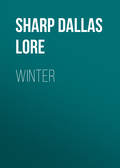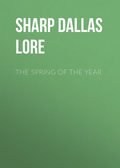
Sharp Dallas Lore
The Lay of the Land
VII
The Sign of the Shad-bush
The shad-bush is open! My bees have seen the sign. They are dropping down upon the alighting-boards of their hives and running with little bags of gold into the still half-closed entrances. During the sunny hours of the last three weeks there has been a quiet buzzing about the hives: the bees have been visiting the early alders, the soft maples, and the dusty-catkined willows; but not before to-day, the first day of the blowing shad-bush, have things been busy at the hives, – have they hummed.
Off along the meadows I can see large patches of garnet against the purple of the sky, – the bloom of the red maples. As I approach, a soft murmur around and through the misty garnet fills the air, like the murmur of a million tiny tongues. Nearer still, and I can see the bees. Here is where they are getting their gold. But not all of it. Some of it to-day is coming from the marsh marigolds.
Early in April, before the shad-bush had opened, or a bee had ventured to the meadows, I picked the first hardy blossom of the marigolds out of icy water, out of mud that had barely thawed. A token this, a promise; but not the sure sign of spring. The bees did not see it; they were waiting, like me, for the shad-bush. So were the marigolds, for to-day the low, wet edge of the meadow ditch is all aglow with the shining of their gold, which the bees are pocketing by the thighful. Among the “flowers,” the marigolds are the first here to offer a harvest for the hives.
The procession is under way. The assembling began weeks ago, with the March hepatica, the stray April arbutus, windflower, spice-bush, and bloodroot. There were saxifrage and everlasting out, too; but they all came singly and timidly. There was no movement of the flowers until the shad-bush opened. Now the marigolds appear in companies, the windflowers drift together, and the hepaticas, leading the line, make a show. The procession of the flowers has started; spring is here.
My spring, I should have said. Your spring came long ago, perhaps, or still delays. “The dandelion tells me when to look for the swallow, the dog-tooth violet when to expect the wood thrush, and when I have found the wake-robin in bloom I know the season is fairly inaugurated. With me this flower is associated, not merely with the awakening of Robin, for he has been awake some weeks, but with the universal awakening and rehabilitation of Nature.”
I watch for the sign of the shad-bush. Spring! There is the smell of spring in the yellow spice-bush; the sound of spring in the trills of the hylas; the color of spring in the blue of the hepatica. A February rain spatters your face with spring; the wild geese trumpet spring in the gray skies as they pass; the bluebird brings spring in spite of your fears and the weather: —
All white and still lie stream and hill —
The winter cold and drear!
When from the skies, a bluebird flies
And – spring is here!
True enough. But then suddenly the bluebird disappears; a heavy snowstorm sets in (as happened not many springs ago), and thousands of the birds perish. Spring was here. It has gone again. And so it will come and go until the shad-bush blooms – for me.
You will not miss one of the returning birds, not even the wild geese; not one of the early flowers, either, by waiting for the shad-bush. The skunk-cabbage and pussy-willow are still in blossom; and still in the woods and fields is the smell of the soil, – that fragrance, that essence which is the breath of the wakening earth. You can yet taste it on the lips of the hepatica, the arbutus, and bloodroot. It still lingers on the early catkins, too, – a strangely rare and delicate odor, that is not of the flowers at all, but of the earth, and sweeter than any perfume that the summer can distill.
It has been a slow, unwilling season until to-day, so slow that the green still shows richest in the sheltered meadows, and the lively color on the rocky slope that runs up from my tiny river is largely the color of mosses and Christmas ferns. Here is a stretch of southern exposure, however, and here are spots where springtime came weeks ago. Already the dog-tooth violets are out in a sunny saucer between the rocks; just above them, on an unshaded shelf, is a patch of saxifrage, and close at hand among the clefts, their “honey pitcher upside down,” swing the first of my columbines.
Yet Spring does not come thus by spots; she does not crawl out and sun herself like a lizard. The columbine seeks the sun, but the hepaticas came up and opened their exquisite eyes in the deepest, dampest shadows of the woods. I have seen them and the lingering snowdrifts together. Many of them are never touched with a sunbeam, their warmth and life coming from within, from a store saved through the winter, rather than from without. Here under the mat of fallen leaves and winter snow they have kept enough of the summer to make a spring.
The fires of summer are never out. They are only banked in the winter, smouldering always under the snow, and quick to brighten and burst into blaze. There came a warm day in January, and across my thawing path crawled a woolly bear caterpillar, a vanessa butterfly flitted through the woods, and the juncos sang. That night a howling snowstorm swept out of the north. The coals were covered again. So they kindled and darkened, until to-day they leap from the ashes of winter, a pure, thin blaze in the shad-bush, to burn higher and hotter across the summer, to flicker and die away, a line of yellow embers in the weird witch-hazel of the autumn.
At the sign of the shad-bush the doors of my springtime swing wide open. My birds are back, my turtles are out, my squirrels and woodchucks show themselves, my garden is ready to plough and plant. There is not a stretch of woodland or meadow now that shows a trace of winter. Over the pasture the bluets are beginning to drift, as if the haze, on the distant hills, floating down in the night, had been caught in the dew-wet grass. They wash the field to its borders in their delicate azure hue.
Along with the bluets (“innocence” we should always call them), under the open sky, there unroll in the wet shaded bottoms of the maple swamps the pointed arum leaves of the Jacks, or Indian turnips. How they fight for room! There are patches where all the pews are pulpits, with some of the preachers standing three deep.
Now why should there be such a scramble for place among the Jacks, while just above them in the dry woods the large showy lady’s-slipper opens in isolated splendor? Here is one, yonder another, with room between for a thousand. Occasionally you will see a dozen together, though not in a crowd; but more often the solitary blossom opens alone and far removed from any of its kind.
The lady’s-slippers, however, are really social compared with the arbutus. Here is a flower that is naturally tribal, – bound together by common root-stalks, trailing shrubby plants that seem free to possess the earth. They were doubtless here in the soil before the Pilgrim came. The angels planted them, I am sure, for they smell of a celestial garden. The paths of heaven are carpeted with them, not paved with gold. But something is the matter with this earthly soil. They grow just where they were originally planted and nowhere else. There was a patch set in the woods three quarters of a mile, as the crow flies, from my front door. That was several millenniums ago. It is there still, a patch as big as my hat. There are other scattered bits of it beyond, but none any nearer to me, yet the soil seems the same, and there are woods all the way between.
Were it as common as the violet, perhaps some of its sweetness would be lost upon us. After all, the heavenly streets may be paved with gold, and instead of a carpet of arbutus, we shall find patches of it only, hidden away under the fallen leaves of the Elysian groves. For we shall need to get out of even the celestial city into the open fields and woods, and I can think of nothing so likely to draw us away from our mansions and beyond the pearly gates as the chance to go “May-flowering.”
And, even here below, among the unransomed souls of Boston, when Mayflower-time arrives, you may see young men and maidens, children and grandfathers, trooping out to the woods for a handful of the flowers. And up from the Cape, to those who cannot go into the woods, the flowers, themselves, come, – tight, naked bunches, stripped of all but the pink of their faces and the sweet of their souls. They possess every quarter of the city. Jew and Gentile sell them, Greek and Barbarian buy them, as they buy and sell no other wild flower.
Why, then, is it not the arbutus, instead of the shad-bush, that spells for me the spring? I don’t know; unless it is because the shad-bush takes deeper hold upon my imagination. It certainly is not its form, or color, or fragrance, – though it has grace, – an airy, misty, half-substantial shape, a wraith in the leafless woods; it has odor, too, and color. But it is something more than all of these that the soft blowing shad-bush means to me. Perhaps the something is in its name, – because it links my inland round with the round of the sea; and because it links this present narrowing round with the wide-winging round of the past.
At the sign of the shad-bush I know the fish are running, – the sturgeon up the Delaware; the shad into Cohansey Creek; and through Five-Forks Sluice, these soft, stirring nights, I know the catfish are slipping. Is there any boy now in Lupton’s Meadows to watch them come? to listen in the moonlit quiet for the splash, splash, as the fish pass up through the main ditch toward the dam?
At the sign of the shad-bush how swiftly the tides of life rise! how mysteriously their currents run! drifting, flying, flowing, creeping – colors, perfumes, forms, and voices – across the heavens, over the earth, and down the deep, dim aisles of the sea! and down the deep, dim aisles of our memories.
VIII
The Nature Movement
I was hurrying across Boston Common. Two or three hundred others were hurrying with me. But ahead, at the union of several paths, was a crowd, standing still. I kept hurrying on, not to join the crowd, but simply to keep up the hurry. The crowd was not standing still, it was a-hurrying, too, scattering as fast as it gathered, and as it scattered I noticed that it wore a smile. I hastened up, pushed in, as I had done a score of times on the Common, and got my glimpse of the show. It was not a Mormon preaching, not a single-taxer, not a dog fight. It was Billy, a gray squirrel, taking peanuts out of a bootblack’s pocket. And every age, sex, sort, and condition of Bostonian came around to watch the little beast shuck the nuts and bury them singly in the grass of the Common.
“Ain’t he a cute little cuss, mister?” said the boy of the brush, feeling the bottom of his empty pocket, and looking up into the prosperous face of Calumet and Hecla at his side. C. and H. smiled, slipped something into the boy’s hand with which to buy another pocketful of peanuts for Billy, and hurried down to State Street.
This crowd on the Common is nothing exceptional. It happens every day, and everywhere, the wide country over. We are all stopping to watch, to feed, and – to smile. The longest, most far-reaching pause in our hurrying American life to-day is this halt to look at the out-of-doors, this attempt to share its life; and nothing more significant is being added to our American character than the resulting thoughtfulness, sympathy, and simplicity, – the smile on the faces of the crowd hurrying over the Common.
Whether one will or not, he is caught up by this nature movement and set adrift in the fields. It may, indeed, be “adrift” for him until he gets thankfully back to the city. “It was a raw November day,” wrote one of these new nature students, who happened also to be a college student, “and we went for our usual Saturday’s birding into the woods. The chestnuts were ripe, and we gathered a peck between us. On our way home, we discovered a small bird perched upon a cedar tree with a worm in its beak. It was a hummingbird, and after a little searching we found its tiny nest close up against the trunk of the cedar, full of tiny nestlings just ready to fly.”
This is what they find, many of these who are caught up by the movement toward the fields; but not all of them. A little five-year-old from the village came out to see me recently, and while playing in the orchard she brought me five flowers, called them by their right names, and told me how they grew. Down in the loneliest marshes of Delaware Bay I know a lighthouse keeper and his solitary neighbor, a farmer: both have been touched by this nature spirit; both are interested, informed, and observant. The farmer there, on the old Zane’s Place, is no man of books, like the rector of Selborne, but he is a man of birds and beasts, of limitless marsh and bay and sky, of everlasting silence and wideness and largeness and eternal solitude. He could write a Natural History of the Maurice River Marshes.
These are not rare cases. The nature books, the nature magazines, the nature teachers, are directing us all to the out-of-doors. I subscribe to a farm journal (club rates, twenty-five cents a year!) in which an entire page is devoted to “nature studies,” while the whole paper is remarkably fresh and odorous of the real fields. In the city, on my way to and from the station, I pass three large bookstores, and from March until July each of these shops has a big window given over almost continuously to “nature books.” I have before me from one of these shops a little catalogue of nature books – “a select list” – for 1907, containing 233 titles, varying in kind all the way from “The Tramp’s Handbook” to one (to a dozen) on the very stable subject of “The Farmstead.” These are all distinctively “nature books,” books with an appeal to sentiment as well as to sense, and very unlike the earlier desiccated, unimaginative treatises.
There are a multitude of other signs that show as clearly as the nature books how full and strong is this tide that sets toward the open fields and woods. There are as many and as good evidences, too, of the genuineness of this interest in the out-of-doors. It may be a fad just now to adopt abandoned farms, to attend parlor lectures on birds, and to possess a how-to-know library. It is pathetic to see “nature study” taught by schoolma’ams who never did and who never will climb a rail fence; it is sad, to speak softly, to have the makers of certain animal books preface the stories with a declaration of their absolute truth; it is passing sad that the unnatural natural history, the impossible out-of-doors, of some of the recent nature books, should have been created. But fibs and failures and impossibilities aside, there still remains the thing itself, – the widespread turning to nature, and the deep, vital need to turn.
The note of sincerity is clear, however, in most of our nature writers; the faith is real in most of our nature teachers; and the love, – who can doubt the love of the tens of thousands of those whose feet feel the earth nowadays, whose lives share in the existence of some pond or wood or field? And who can doubt the rest, the health, the sanity, and the satisfaction that these get from the companionship of their field or wood or pond?
There is no way of accounting for the movement that reflects in the least upon its reality and genuineness. It may be only the appropriation by the common people of the world that the scientists have discovered to us; it may be a popular reaction against the conventionality of the eighteenth century; or the result of our growing wealth and leisure; or a fashion set by Thoreau and Burroughs, – one or all of these may account for its origin; but nothing can explain the movement away, or hinder us from being borne by it out, at least a little way, under the open of heaven, to the great good of body and soul.
Among the cultural influences of our times that have developed the proportions of a movement, this so-called nature movement is peculiarly American. No such general, widespread turning to the out-of-doors is seen anywhere else; no other such body of nature literature as ours; no other people so close to nature in sympathy and understanding, because there is no other people of the same degree of culture living so close to the real, wild out-of-doors.
The extraordinary interest in the out-of-doors is not altogether a recent acquirement. We inherited it. Nature study is an American habit. What else had the pioneers and colonists to study but the out-of-doors? and what else was half as wonderful? They came from an old urban world into this new country world, where all was strange, unnamed, and unexplored. Their chief business was observing nature, not as dull savages, nor as children born to a dead familiarity with their surroundings, but as interested men and women, with a need and a desire to know. Their coming was the real beginning of our nature movement; their observing has developed into our nature study habit.
Our nature literature also began with them. There is scarcely a journal, a diary, or a set of letters of this early time in which we do not find that careful seeing, and often that imaginative interpretation, so characteristic of the present day. Even the modern animal romancer is represented among these early writers in John Josselyn and his delicious book, “New England’s Rarities Discovered.”
It was not until the time of Emerson and Bryant and Thoreau, however, that our interest in nature became general and grew into something deeper than mere curiosity. There had been naturalists such as Audubon (he was a poet, also), but they went off into the deep woods alone. They were after new facts, new species. Emerson and Bryant and Thoreau went into the woods, too, but not for facts, nor did they go far, and they invited us to go along. We went, because they got no farther than the back-pasture fence. It was not to the woods they took us, but to nature; not a-hunting after new species in the name of science, but for new inspirations, new estimates of life, new health for mind and spirit.
But we were slow to get as far even as their back-pasture fence, slow to find nature in the fields and woods. It was fifty years ago that Emerson tried to take us to nature; but fifty years ago, how few there were who could make sense out of his invitation, to say nothing of accepting it! And of Thoreau’s first nature book, “A Week on the Concord and Merrimack Rivers,” there were sold, in four years after publication, two hundred and twenty copies. But two hundred and twenty of such books at work in the mind of the country could leaven, in time, a big lump of it. And they did. The out-of-doors, our attitude toward it, and our literature about it have never been the same since.
Even yet, however, it is the few only who respond to Thoreau, Emerson, and Burroughs, who can find nature, as well as birds and trees, who can think and feel as well as wonder and look. Before we can think and feel we must get over our wondering, and we must get entirely used to looking. This we are slowly doing, – slowly, I say, for it is the monstrous, the marvelous, the unreal that most of us still go out into the wilderness for to see, – bears and wolves, foxes, eagles, orioles, salmon, mustangs, porcupines of extraordinary parts and powers.
There came to my desk, tied up with the same string, not long since, three nature books of a sort to make Thoreau turn over in his grave, – accounts of beasts and birds such as old Thetbaldus gave us in his “Physiologus,” that pious and marvelous bestiary of the dark ages. These three volumes that I refer to are modern and about American animals, but they, too, might have been written during the dark ages. All three have the same solemn preface, declaring the absolute truth of the observations that follow (as if we might doubt?), and piously pointing out their high moral purpose; all three likewise start out with the same wonderful story, – an animal biography: one, of a slum cat, born in a cracker box. Among the kittens of the cracker box was an extraordinary kitten of “pronounced color,” who survives and comes to glory. The next book tells the biography of a fox, born in a hole among the Canadian hills. Among the pups born in this hole was one extraordinary pup “more finely colored” than the others, who survives and comes to glory. The third book tells the biography of a wolf, born in a cave among the rocks, still farther north. Among the cubs born in this cave was one extraordinary cub, “larger than the others,” who survives and, as is to be expected of a wolf, comes to more glory than the cracker-box kitten or the fox pup of the hills.
Such are the stories that are made into texts and readers for our public schools; such are the animals that go roaming through the woods of the American child’s imagination. But no such kittens or cubs or pups lurk in my eight-acre woodlot. I have seen several (six, to be exact) fox pups, but never did I see this overworked, extraordinary, cum laude pup of the recent nature books.
So long as we continue to read and believe such accounts, just so long shall we find it impossible to go with Audubon and Thoreau and Burroughs, for they have no place to take us, nothing to show us when we arrive. Their real world does not exist.
But we know that a real, ordinary, yet a marvelous world does exist, and right at hand. The present great nature movement is an outgoing to discover it, – its trees, birds, flowers, its myriad forms. This is the meaning of the countless manuals, the “how-to-know” books, and the nature study of the public schools. And this desire to know Nature is the reasonable, natural preparation for the deeper insight that leads to communion with her, – a desire to be traced more directly to Agassiz, and the hosts of teachers he inspired, perhaps, than to the poet-essayists like Emerson and Thoreau and Burroughs.
Let us learn to see and name first. The inexperienced, the unknowing, the unthinking, cannot love. One must live until tired, and think until baffled, before he can know his need of Nature; and then he will not know how to approach her unless already acquainted. To expect anything more than curiosity and animal delight in a child is foolish, and the attempt to teach him anything more at first than to know the out-of-doors is equally foolish. Poets are born, but not until they are old.
But if one got no farther than his how-to-know book would lead him, he still would get into the fields, – the best place for him this side of heaven, – he would get ozone for his lungs, red blood, sound sleep, and health. As a nation, we had just begun to get away from the farm and out of touch with the soil. The nature movement is sending us back in time. A new wave of physical soundness is to roll in upon us as the result, accompanied with a newness of mind and of morals.
For, next to bodily health, the influence of the fields makes for the health of the spirit. It is easier to be good in a good body and an environment of largeness, beauty, and peace, – easier here than anywhere else to be sane, sincere, and “in little thyng have suffisaunce.” If it means anything to think upon whatsoever things are good and lovely, then it means much to own a how-to-know book and to make use of it.
This is hardly more than a beginning, however, merely satisfying an instinct of the mind. It is good if done afield, even though such classifying of the out-of-doors is only scraping an acquaintance with nature. The best good, the deep healing, come when one, no longer a stranger, breaks away from his getting and spending, from his thinking with men, and camps under the open sky, where he knows without thinking, and worships without priest or chant or prayer.
The world’s work must be done, and only a small part of it can be done in the woods and fields. The merchants may not all turn ploughmen and wood-choppers. Nor is it necessary. What we need to do, and are learning to do, is to go to nature for our rest and health and recreation.







